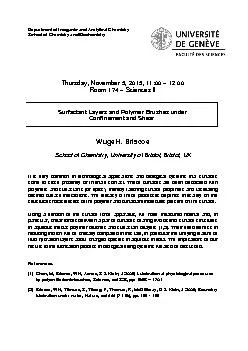

and Analytical Chemistry School of Chemistry and Biochemistry Thursday November 5 201 5 1 1 0 0 1 2 0 0 Room 174 Sciences I I Wuge H Briscoe School of Chemistry University of B ID: 836655
Download Pdf The PPT/PDF document "Department of Inorganic" is the property of its rightful owner. Permission is granted to download and print the materials on this web site for personal, non-commercial use only, and to display it on your personal computer provided you do not modify the materials and that you retain all copyright notices contained in the materials. By downloading content from our website, you accept the terms of this agreement.
1 Department of Inorganic and Analytic
Department of Inorganic and Analytical Chemistry School of Chemistry and Biochemistry Thursday , November 5 , 201 5 , 1 1 : 0 0 – 1 2 : 0 0 Room 174 – Sciences I I Wuge H. Briscoe School of Chemistry, University of Bristol, Bristol, UK It is very common in technological applications and biological systems that surfaces come to close proximity or intimate contact. These surfaces are often decorated with polymers and surfactants (or lipids), thereby tailoring surface properties and facilitating desired surface interactions. The efficacy of these processes depends intricately on the structural characteristics of the polymer and surfactant molecules present on the surface. Using a ve rsion of the surface force apparatus, we have measured normal and, in particular, shear forces between a pair of surfaces bearing two distinct surface structures in aqueous media: polymer brushes and surfactant bilayers [ 1,2 ] . Their effectiveness in reducing fri ction will be critically compared in this talk, in particular the unifying feature of fluid hydration layers about charged species in aqueous media. The implications of our results to the lubrication process in biological living systems will also be discus sed. References [1 ] Chen, M, Briscoe, WH, Armes, S & Klein, J 2009, Lubrication at physiological pressures by polyzwitterionic brushes , Science , vol 323, pp. 1698 – 1701 [2] Briscoe, WH, Titmuss, S, Tiberg, F, Thomas, R, McGillivray, D & Klein, J 2006, Boundary lubrication under water , Nature , vol 444 (7116), pp. 191 - 194 Surfactant L ayers and P olymer B rushes under C onfinement and S hear